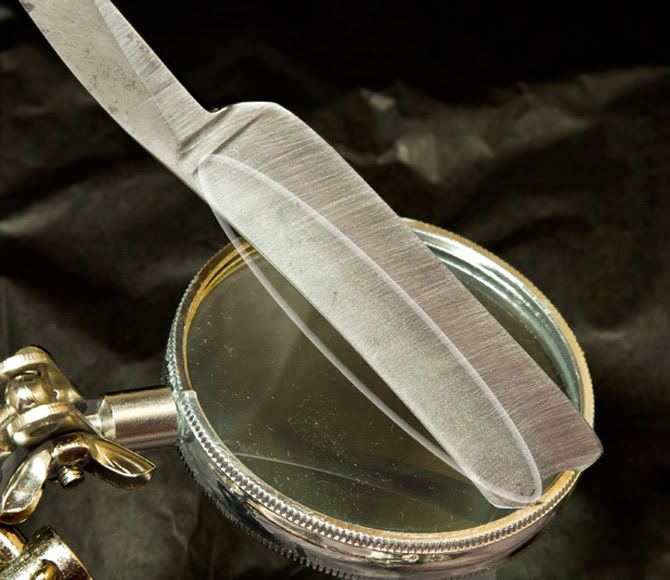Results 1 to 10 of 17
Thread: Did I lose temper on this blade?
Hybrid View
-
01-08-2011, 05:00 AM #1
 Did I lose temper on this blade?
Did I lose temper on this blade?
I'm new to restoration; any help would be appreciated. The picture below shows my blade after it's been run across my buffing wheel during first phase—using 80 grit grease-less compound. I paused as soon as I saw that part of my blade was reflecting the buffing-scratches differently. I'm unsure if this part of the blade has just been buffed more than the rest, or, is this temper loss causing color change. It was very hard to get a photo of the area that looks discolored; look closely where there's a faint white circle. Is this what overheating looks like?
 I'm using 4" cotton sewn wheels with a 3450 rpm machine; I am aware that this rpm can heat a blade quickly. Thanks for any help.
I'm using 4" cotton sewn wheels with a 3450 rpm machine; I am aware that this rpm can heat a blade quickly. Thanks for any help.

-
01-08-2011, 06:20 AM #2illegitimum non carborundum



- Join Date
- Jan 2008
- Location
- Rochester, MN
- Posts
- 11,552
- Blog Entries
- 1
Thanked: 3795
It's hard to tell from the photo, but I doubt it. In general overheating is indicated by various darker shades of blue/gray/black. Regardless of the state of this razor, when you are buffing the blade should never be allowed to reaching a temperature that is hot to the touch. Keep it cool! Watch the pressure--the more pressure you apply, the faster the blade gets hot.
-
01-08-2011, 06:24 AM #3

That look more you have a more even scratch pattern there to me
The thinner part of the blade heat way quicker than the part you are conserned about
Heat discoloration happen after the temper is ruined so lack of it doesnt mean you are safe.
Im actually more conserned about the hue you have closer to the edge
I usually se it as shades of brown and blueLast edited by janivar123; 01-08-2011 at 06:27 AM.
-
01-08-2011, 07:00 AM #4This is not my actual head.



- Join Date
- Nov 2009
- Location
- Middle of nowhere, Minnesota
- Posts
- 4,624
- Blog Entries
- 2
Thanked: 1371
Unrelated to the temper: If those scratches are from your buffer, try using less pressure in the future.
Strange women lying in ponds distributing swords is no basis for a system of government.
-
01-08-2011, 10:52 AM #5"My words are of iron..."


- Join Date
- Oct 2006
- Posts
- 1,898
Thanked: 995
Another possible answer is that the blade is harder at the edge and softer at the spine. This would allow the cutting grit of the polishing to move more material where the blade was softer. But it doesn't have the expected features of lost temper due to polishing.
“Nothing discloses real character like the use of power. Most people can bear adversity. But if you wish to know what a man really is, give him power.” R.G.Ingersoll
-
The Following User Says Thank You to Mike Blue For This Useful Post:
Maximilian (01-08-2011)
-
01-08-2011, 11:24 AM #6

To lose temper, don't you have to heat the steel to more than 150C? Wouldn't you burn yourself way before you reached any danger to the steel?
-
01-08-2011, 01:06 PM #7illegitimum non carborundum



- Join Date
- Jan 2008
- Location
- Rochester, MN
- Posts
- 11,552
- Blog Entries
- 1
Thanked: 3795
Both are critical points I failed to point out.
Personally, I don't see anything wrong with those scratches given that they are from 80 grit compound.
As was already pointed out, the thin edge heats much more quickly. By the time you feel the heat in the tang and spine, where you might be holding it, the temperature at the edge already could be too hot. Just overheating one small area can still trash the whole blade.


 LinkBack URL
LinkBack URL About LinkBacks
About LinkBacks






 Reply With Quote
Reply With Quote



